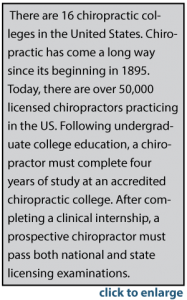Dr. Petchauer practices a type of chiropractic called “The Gonstead Technique.” There are many different methods of chiropractic, but “Gonstead” stands alone in its unique approach in both analyzing and treating the spine. It was developed by Dr. C.S. Gonstead over the course of his 50 years of chiropractic practice. Using his mechanical engineering background and extensive hours spent studying cadaver spines; his method took chiropractic from a non-specific general manipulation of the spine to a very precise and specific means of correcting spinal problems. His skill brought him both national and international acclaim, and his practice in Wisconsin drew patients from all over the world. Dr. Gonstead’s brilliant mind and lifelong experience of treating thousands of patients enabled him to refine his technique which is now taught and practiced by other chiropractors.
Often the question is asked, why do so few chiropractors practice the Gonstead method? To become an advanced practitioner of this type of chiropractic requires years of study and commitment. It involves attending numerous post-graduate classes that are held throughout the country. Unfortunately, not many chiropractors take on the challenge of mastering the Gonstead system. For a list of chiropractors specializing in the Gonstead method, see www.gonsteadseminar.com/referral.aspx
 Gonstead chiropractic involves a logical and thorough method for analyzing the spine and nervous system. A visual exam observing how a person walks, stands, sits, and moves can reveal subtle abnormalities indicating musculoskeletal problems. A nervoscope, an instrument that measures abnormal heat patterns along the spine, is used not only to help locate a problem but to objectively monitor a patient’s response to treatment. A spinal exam consists of both static and motion palpation. Static palpation detects muscle tightness and imbalances, areas of swelling or tenderness, and other soft tissue irregularities indicating a spine that is not properly functioning. Motion palpation involves putting each of the spinal vertebrae through a test to see if they can perform all of their normal ranges of motion. The loss of motion is the cardinal sign of a spinal problem, not only causing symptoms now, but spinal decay and disc degeneration in the future. An x-ray exam is vital; it allows the chiropractor to actually see the individual vertebrae. Not only do x-rays show abnormalities such as bone disease, malformations, arthritis, osteoporosis, and abnormal curves; they determine if spinal adjustments are the appropriate treatment. X-Rays are also vital because they are the blueprint of how the spinal bone needs to be moved or adjusted. Gonstead chiropractors use a special x-ray analysis procedure developed by Dr. Gonstead to assure the most specific and accurate spinal adjustment.
Gonstead chiropractic involves a logical and thorough method for analyzing the spine and nervous system. A visual exam observing how a person walks, stands, sits, and moves can reveal subtle abnormalities indicating musculoskeletal problems. A nervoscope, an instrument that measures abnormal heat patterns along the spine, is used not only to help locate a problem but to objectively monitor a patient’s response to treatment. A spinal exam consists of both static and motion palpation. Static palpation detects muscle tightness and imbalances, areas of swelling or tenderness, and other soft tissue irregularities indicating a spine that is not properly functioning. Motion palpation involves putting each of the spinal vertebrae through a test to see if they can perform all of their normal ranges of motion. The loss of motion is the cardinal sign of a spinal problem, not only causing symptoms now, but spinal decay and disc degeneration in the future. An x-ray exam is vital; it allows the chiropractor to actually see the individual vertebrae. Not only do x-rays show abnormalities such as bone disease, malformations, arthritis, osteoporosis, and abnormal curves; they determine if spinal adjustments are the appropriate treatment. X-Rays are also vital because they are the blueprint of how the spinal bone needs to be moved or adjusted. Gonstead chiropractors use a special x-ray analysis procedure developed by Dr. Gonstead to assure the most specific and accurate spinal adjustment.
The above procedures give the Gonstead chiropractor the information he or she needs to perform an accurate spinal adjustment. All of the adjustments given are of the Gonstead type, which means they are never general manipulations. Adjustments are never forced or utilize torquing or twisting as is common in chiropractic techniques, but are biomechanically correct to assure safety and quick progress. All of the adjusting tables used are genuine Gonstead equipment. For more information on Gonstead chiropractic – see www.gonsteadseminar.com
| Also subscribe to |

Helping you uncover and treat the real cause of your health problems. |



